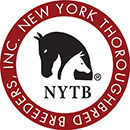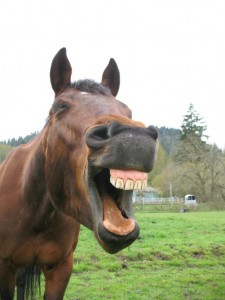This week we will be speaking with Peter Penny, one of the foremost yearling inspectors for the Fasig-Tipton Sales company and Fasig’s Florida and New York representative.
Peter thank you for taking some time out of what must be your busiest time of year. I’m sure you are logging many miles getting to each and every farm to inspect yearlings for the upcoming Summer sales. I’d like to speak with you about some of the ways people can facilitate the inspection of their prized yearlings when you arrive to look them over. Your work has certainly paid off over the years because the averages in the summer select sales most notably the NY Bred Preferred sale has gone up on a yearly basis and continues to be one of the best places to purchase a nice yearling. It’s NYTB’s Flagship sale and we appreciate the work you and Fasig-Tipton have put into making it what it is today; a strong market in our home marketplace.
We know how special we feel when one of our horses is accepted to one of the Summer select sales. But as we both know the process starts in January with the free nomination provided by Fasig-Tipton on the website and through direct mail.
Is it too late to still get a nomination in to Fasig-Tipton for those who may have overlooked the due date?
No it is not too late to get a horse nominated to our sales. We are fairly flexible with our nomination deadlines, because we realize they do come up fast, and people can overlook them. We do ask you please get them in as soon as possible, because we are in certain areas only once, with a tight schedule, and have to set up times and dates accordingly.
What is the process that takes place in house from when Fasig-Tipton receives the nomination and when you are given a list of yearlings to inspect?
When the nomination is received, it is put into our database. Then it will be sorted by location, state, city, farm, etc. Once that is done the various locations are plotted on a map, by way of mapping software. Then the various trips are lined up, people are called with the exact time and date we will be coming to inspect. Once all stops are confirmed, all the information is downloaded onto the individual inspectors IPAD. We have developed software that really makes it a lot easier than in the past when we used to just use inspection cards. It provides us with information that helps us to decide on which sale that particular horse fits best, it includes, foaling date, pedigrees, sire yearling averages, and pinhook prices. All this is coordinated by Vicki Cooper, and her staff in our Ky. office. They really do a great job, and make our jobs a whole lot easier.
Why does Fasig-Tipton select the horses by pedigree first rather than have you inspect everyone that is nominated?
Unfortunately we have a limited number of stalls at the sales grounds in Saratoga, and as you can imagine our nominations go up every year because of the increased foal crop in N.Y. This sale has really improved over the last few years, and its average has steadily increased each year. This process helps us bring down the numbers to a manageable level.
Once you get the list of yearlings to inspect what is the general schedule you will follow timeline wise from state to state? (very generally what month what state?)
We inspect in March and April. We usually start with the south eastern states, due to weather considerations. We start with the Carolina’s, Ga., Ca., TX, La., and Fl., in early March, and then move north in late March, and April. This will include Md., Pa., VA., and De. , Ky., N.Y., and Can.
When the owner is contacted by Fasig-Tipton that you will be stopping by to inspect yearlings, what is the average lead time?
When a horse is nominated, we send out a letter with our tentative inspection schedule for that year. We then try very hard to give the owner at least a week notice before we are due to inspect.
Once a farm is contacted what can they do to get their yearling ready for your visit? Blacksmith? Previously handled, schooling to walk properly? In the barn ready to show rather than out in the field? Separate colts from fillies?
It is really not for me to tell an individual owner what to do with their horse. The horsemanship level in N.Y. has improved quite a bit over the last several years, and most people know what we are looking for. The one thing I would like to get across though is, in most cases, we only get one chance to look at your horse, so I think anything that can be done to make it easier for us to get a good look at the horse, and show that horse in the best light on that day, helps with our inspections. I don’t want people to take that as us being prima donna’s, that’s not the case at all. We try very hard to accommodate everyone the best we can, and we can look through a lot of things and don’t have a problem with that, but whatever you can do to give us the best opportunity to really get a good look at your horse helps tremendously.
What will you ask the handler to do with the yearling during the inspection?
It’s really a pretty simple process. We basically ask them to stand the horse up squarely, so we can get a good look at the overall conformation, and then walk them in a straight line, away from us and then back toward us, so we can see any deviations with the front and hind end. Sometimes we will ask them to walk several times to get a better look at the overall stride.
Once the inspection is over if a person wants to get an idea where they stand will you provide that information?
We are very lucky Fasig-Tipton has the confidence in us to be able to give the owner our decision right there on the spot. We find that is the best way to do it. We look at hundreds of horses over a period of two months, and we have found it is best to decide when it is fresh in your mind, not three or four weeks later, after you have inspected many more horses. In some cases we can’t give them a decision on that day, for a variety of reason, but we will definitely let everyone know before the first of May. We don’t want anyone to have to pay an entry fee for another sales company due to us.
Do some horses demand a second inspection and if so why?
Due to the time constraints, most of the time, we really can’t get a second look. That is why, as I mentioned earlier, it’s best to have your horse looking as good as possible. There are cases when a second look is necessary. Most of the time it is due to an injury and the owner asks us to come back. Depending on location, we do try to accommodate them.
In your experience what basic characteristics makes for a better sale horse from a physical standpoint?
To me the most important characteristic is overall balance. A horse that has some stretch, and leg. A good length to the neck and shoulder are really important. A nice square hip, with a hind leg that doesn’t have too much bend or not too far behind the point of the hip. Unfortunately as inspectors we have to pick apart the overall conformation of the legs, because that’s what the market place demands, but if you see a horse that has real good balance, and looks like an athlete, you usually don’t go wrong accepting them.
Are you looking for certain sire lines our do all physical stand outs generally make the grade?
Of course pedigree matters but, within reason, the physical is the most important thing we look for. We have prided ourselves in selecting the best physical horses over the years, and it has served us very well. That’s why you see a very high percentage of Fasig-Tipton graduates, from all our sales; do so well at the races.
I’ve heard for years how people think if their horse is accepted into a “saratoga” sale it will automatically make the price go up and if it is not accepted then it’s a big disappointment; name calling, blame game, road rage, etc, etc. Does the sale make the horse or does the horse make the sale?
That’s an easy question to answer. The horse makes the sale. I don’t care where you have a sale, if you don’t have the horses it just doesn’t work. Believe me, we don’t like to turn down horses, but we try and do the best we can to get the best possible horses that fit our various sales. The market today is very tough, and placing your horse in the right spot can make all the difference. In many cases Saratoga is not the right spot for a horse. It might be a very late foal, immature, and need more time. Horses change so much in a very short time, and the extra couple months can often determine your sales success.
Since you are looking at the outside of the horse and you like what you see that is not always “the end of the story” is it? Unfortunately these days the owners of the horses have to be prepared with what is on the inside of the horse having to provide repository x-rays and scope within 10 days of the sale date. When would you recommend a set of forecast X-rays taken so the owner has time to clean things up if need be for the upcoming sale?
Unfortunately you are right about not being “The End of the Story”. Vetting has become a big issue nowadays. It is a major factor in determining whether you get your horse sold, and I do recommend people check beforehand to see if anything needs cleaning up. I think you will find most people start doing the “forecast” X-rays and scope within the next couple of months. I would recommend talking to your individual veterinarians about when to do them. They have the experience, and know what the recuperation periods are for various procedures.
Again thanks for your time and I am sure the information you have provided will be helpful to many breeders and owners out there. Thanks for all the work you do to provide us with a great marketplace for our home grown product!
Watch for more helpful interviews and save the date for our next LIVE Educational Seminar on April 30 at the Fasig-Tipton pavilion! If you have any questions for Mr. Penny or comments, questions, feedback or suggestions for future dialogue, feel free to email them to info@nytbreeders.org.










